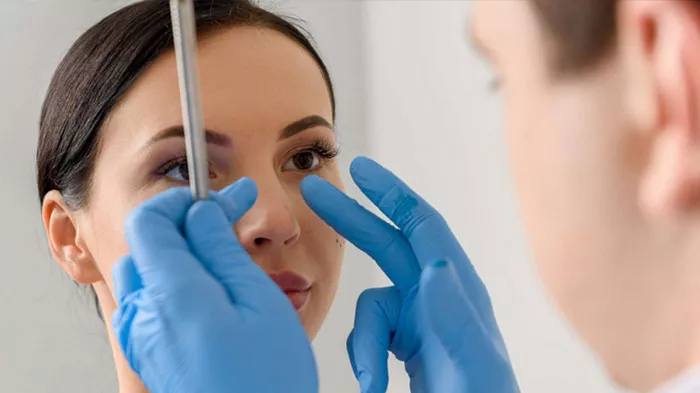Rhinoplasty, commonly referred to as a “nose job,” is a surgical procedure aimed at reshaping and altering the appearance of the nose. However, not everyone is ready or willing to undergo invasive surgery. Fortunately, non-surgical rhinoplasty offers an alternative for individuals seeking nasal enhancement without going under the knife. In this article, we will explore non-surgical rhinoplasty, including what it entails, the factors affecting its cost, and what you can expect in terms of pricing.
Understanding Non-Surgical Rhinoplasty
Non-surgical rhinoplasty, also known as liquid rhinoplasty or non-surgical nose job, involves the use of injectable fillers to enhance and reshape the nose. It is a minimally invasive procedure that can address various aesthetic concerns, such as nasal asymmetry, dorsal humps, mild to moderate depressions, and nasal tip refinement.
The procedure typically involves the injection of dermal fillers, such as hyaluronic acid-based products, into specific areas of the nose to achieve the desired results. These fillers can provide volume, reshape contours, and improve the overall appearance of the nose. Non-surgical rhinoplasty is a quick procedure that can often be completed in a single office visit, with minimal downtime and recovery.
Factors Affecting the Cost of Non-Surgical Rhinoplasty
Several factors influence the cost of non-surgical rhinoplasty. It’s important to note that the cost can vary significantly depending on the region, the experience of the provider, and the specific requirements of each individual. Here are the key factors that can influence the overall cost:
1. Geographic Location
The cost of non-surgical rhinoplasty can vary based on the geographic location. Prices tend to be higher in metropolitan areas and regions with a higher cost of living. For example, procedures performed in major cities or upscale neighborhoods may have a higher price range compared to those in smaller towns or less affluent areas.
2. Provider’s Experience and Reputation
The expertise and reputation of the provider performing the non-surgical rhinoplasty can impact the cost. Highly experienced and reputable practitioners may charge more due to their expertise, skill, and track record of successful outcomes. It’s important to research and choose a qualified, board-certified professional with extensive experience in performing non-surgical rhinoplasty.
3. Type and Quantity of Fillers Used
The type and quantity of dermal fillers required to achieve the desired results will also affect the overall cost. Different fillers have varying costs, and the amount needed depends on the individual’s specific nasal anatomy, goals, and the extent of correction required.
4. Additional Services or Procedures
Non-surgical rhinoplasty may sometimes be combined with other treatments or procedures to enhance the overall results. For example, additional treatments such as Botox injections to address wrinkles or other facial rejuvenation procedures may be recommended. These additional services or procedures can add to the total cost.
5. Consultation Fees
Some providers may charge a separate consultation fee, which is typically paid during the initial consultation. The consultation fee covers the time spent evaluating the patient’s nasal structure, discussing expectations, and creating a personalized treatment plan.
Estimating the Cost Range
It is important to note that the cost of non-surgical rhinoplasty can vary significantly depending on the factors mentioned above. On average, the cost of non-surgical rhinoplasty can range from $500 to $3,000 or more. However, this is a rough estimate and may not reflect the actual cost for your specific case.
It’s crucial to consult with a qualified provider to determine the most accurate cost estimate based on your individual needs. During the consultation, the provider will evaluate your nasal structure, discuss your goals, and develop a personalized treatment plan. They will provide you with a comprehensive breakdown of the costs involved, including the price of fillers, any additional services, and the provider’s fees.
Considerations and Risks
While non-surgical rhinoplasty offers a less invasive alternative to traditional surgical rhinoplasty, it’s important to consider the following:
Temporary Results: The results of non-surgical rhinoplasty are temporary and typically last between 6 to 18 months, depending on the type of filler used and the individual’s metabolism. Maintenance treatments are necessary to sustain the desired outcome.
Limitations: Non-surgical rhinoplasty has its limitations and may not be suitable for everyone. It is best suited for individuals with mild to moderate nasal imperfections. Extensive structural changes or functional corrections may require surgical intervention.
Potential Risks: While non-surgical rhinoplasty is generally considered safe, there are potential risks and complications associated with the procedure. These can include infection, bruising, swelling, asymmetry, and rare instances of vascular complications. Choosing a skilled and experienced provider reduces the risk of complications.
Individual Variations: Each individual’s anatomy and aesthetic goals are unique, which means the cost and approach to non-surgical rhinoplasty will vary accordingly. A comprehensive consultation with a qualified provider is essential to assess your specific needs and develop a personalized treatment plan.
Making an Informed Decision
Before proceeding with non-surgical rhinoplasty, it’s important to research and choose a reputable provider who specializes in the procedure. Look for a board-certified professional with extensive experience in facial aesthetics and a track record of successful outcomes. During the consultation, be sure to discuss your goals, concerns, and any questions you may have about the procedure and its associated costs.
Remember that cost should not be the sole determining factor when choosing a provider. The skill, experience, and reputation of the practitioner are equally important considerations. Prioritize safety, quality, and achieving your desired results when making your decision.
Conclusion
Non-surgical rhinoplasty provides an alternative option for individuals seeking nasal enhancement without undergoing surgery. The cost of non-surgical rhinoplasty can vary based on geographic location, provider experience, type and quantity of fillers used, additional services, and consultation fees. It is essential to consult with a qualified provider to determine an accurate cost estimate and to ensure that your expectations align with the potential results of the procedure. Remember to prioritize safety, research reputable providers, and discuss any concerns or questions during the consultation process. By taking a personalized approach, you can make an informed decision and achieve your desired nasal aesthetic through non-surgical rhinoplasty.


